BOE has been making a bigger and bigger impact at each of the last several SID Display Weeks and this year it impressed even more.
We started by looking at a flexible OLED concept that used a 7.56″ display with 2048 x 1536 resolution and an outside fold (display surface on the outside of the bend) radius of 5mm. The panel is 0.24mm thick, we heard and the company said that it has tested the bending more than 100,000 times.
 BOE’s Flexible OLEDs are clearly still a work in progress, but indicate the likely form of early products. Images: Meko
BOE’s Flexible OLEDs are clearly still a work in progress, but indicate the likely form of early products. Images: Meko
There was also a 5.5″ FullHD flexible AMOLED with 380 cd/m² of output and bezels of just 0.85mm on three sides, with 2.4mm on the bottom. The display uses a GGRB pixel arrangement.
Moving on, we looked at dual VR displays with 2160 x 2376 resolution and 3.5″ diagonal (917 ppi) with support for 90Hz refresh, a response time of 5ms and a 100º field of view. Latency is quoted at less than 20ms. A second display is designed for a dedicated single display with 3840 x 2160 resolution on a 5.7″ diagonal (773 ppi). Refresh rate is 75Hz and response is 5ms (G2G max). Latency is less than 20ms.
We also looked at a 2.1″ 3240 x 3600 display with 2300 ppi and 90Hz frame rate and 5ms response time. Another VR display was a 1.8″ 1200 x 1280 OLED with 1000 ppi. BOE is also working on chip-based displays and there was a 0.41″ 800 x 480 OLED with 2,275 ppi and a fast response time.
Finally, we looked at a 3.5″ display with 4320 x 4800 resolution on a 3.5″ diagonal – creating a 20.7 megapixel panel. (as reported from Google’s keynote, that company said that it was working on a 20 megapixel display for VR with a supplier, although it didn’t identify BOE, so it could be another). The resolution means that the display has 1900 ppi.
For augmented reality, there was a 0.5″ 800 x 600 micro OLED that has 2000 ppi with a built-in gyroscope. Refresh rate is 85Hz.
After these displays, we moved to the touch area, where BOE was showing in cell OLED with touch of 1.53″ diagonal and 240 x 240 resolution. Brightness is 1,000 cd/m² and the display supports 10 point touch (although that seems academic on such a display – Man. Ed.)
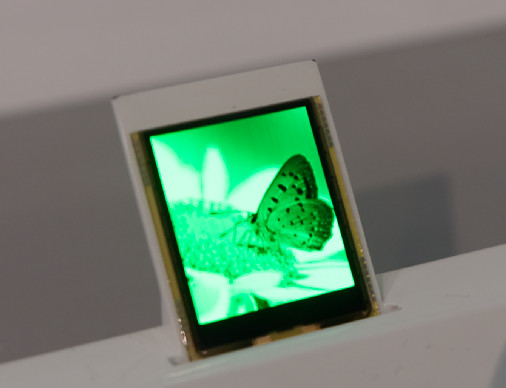 BOE’s In Cell Touch OLED has 10 touch points. Image:Meko
BOE’s In Cell Touch OLED has 10 touch points. Image:Meko
A new development is a new 5.5″ 2560 x1440 LTPS OLED with 380 cd/m² of brightness and 110% of NTSC colour. The flexible display (4mm radius) supports touch, but can also detect force from one or more fingers. There was also a 10.1″ 800 x 1280 MLOC (Multi Layers on-cell) force touch display that uses a force sensor embedded in the BLU.
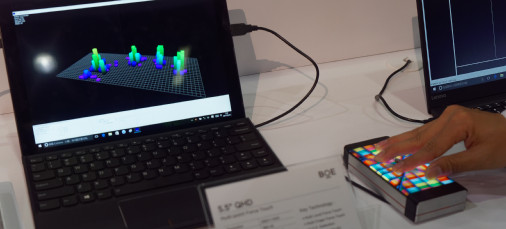 BOE showed this force sensing display – the data on the screen on the left is from the display on the right. Image:Meko
BOE showed this force sensing display – the data on the screen on the left is from the display on the right. Image:Meko
Turning to larger screens, BOE had a number of FullHD, UltraHD and 8K displays. The company had a very good anti-glare surface on the displays and they were being used to show art works, with the panels mounted in frames so that when they are not being used for video (or data), they look very good with the paintings. BOE told us that it is licensing artworks from museums and galleries. We asked about power consumption and we heard that the 8K 27″ IPS LCD panel takes 200W when showing a static image. It is claimed to have a 4.5% aperture ratio and supports 100% of Adobe RGB.
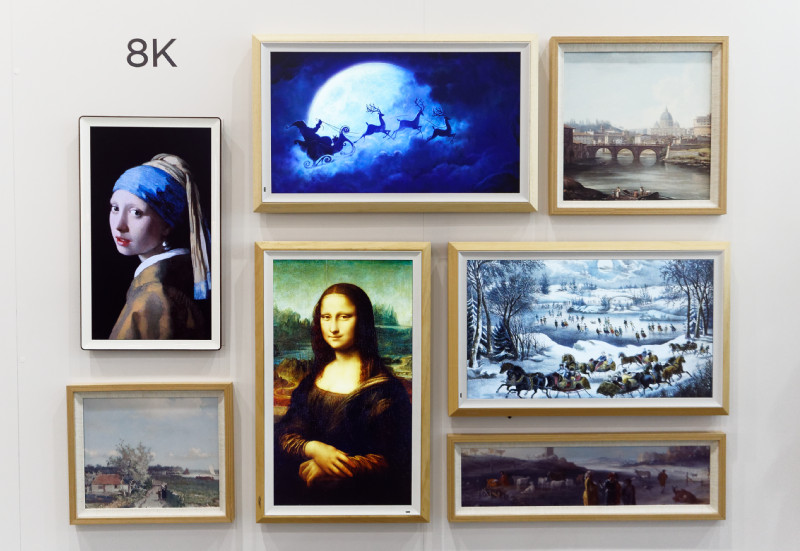 BOE told us it is licensing artworks for display. Image:Meko
BOE told us it is licensing artworks for display. Image:Meko
The company has developed a 5.2″ FullHD display that is said to be lower in potentially dangerous blue light emissions, by moving the blue peak wavelength from 450 nm to 460 nm. That, BOE says, reduces the potentially damaging blue light from 20% of the output to 8%.
The next display we looked at was a 5.7″ UltraHD display (773 ppi) with 85% NTSC and 590 cd/m² and 1,500:1 contrast. Borders are 0.7/0.7/0.8/6.2 mm. The display supports what BOE calls Smart View, where the display will switch to FullHD operation, when the driving power consumption (with touch) drops from 230 mW to 150 mW.
There was a 5.99″ HD display with 18:9 aspect ratio for ‘full screen display’ (and allowing that technology to move into mainstream displays) that will be available in mass production in JUly.
BOE is still looking at 3D and had a 5.5″ 2560 x 1440 (using a-si) which can switch between 2D and 3D and using eye tracking to modify the stereo image shown. The display is designed to be viewed from 34cm and with 300 cd/m² of output in the S3D mode.
Turning to notebook displays. the company had a 13.3″ FullHD display that is fitted with a privacy filter that is based on a bistable LCD that controls the viewing angle. Further around the booth, the company had a 9.6″ dual view display (each view of 640 x 800) suitable for automotive that split the views between, for example, a driver and passenger. (Note, Sharp has shown this kind of panel in the past. It can be essential in automotive as in countries such as Germany, a driver must not be able to see video. Man. Ed.). The display has 500 cd/m² and the best viewing angle is 40º. It is based on BOE’s ADSDS (FFS/IPS equivalent).
There was a 15.6″ in-cell touch FullHD curved LCD (900mm radius) that is for automotive applications and uses a curved BLU. Brightness is 1,000 cd/m².
Moving up to bigger notebooks. the company was showing an 18.4″ UltraHD LCD that is said to be the first panel of that size and resolution in the world. The panel has 260 cd/m² of output with 1,200:1 contrast and 110% coverage of Adobe RGB. The response time of the panel is 16ms and the panel has three side COG construction.
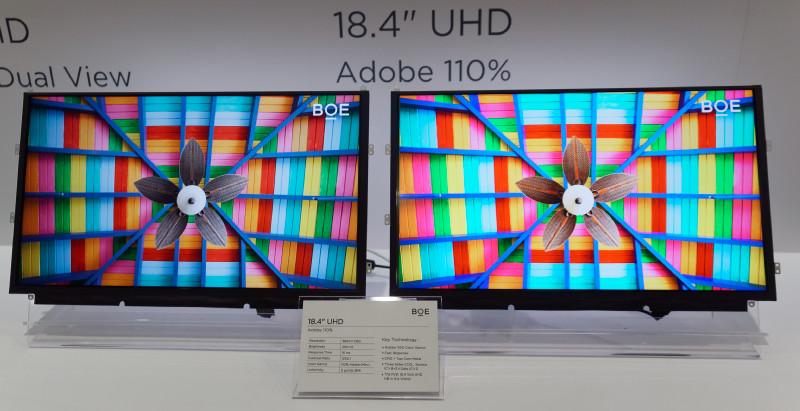
A new 32″ ‘Speed Curve’ display has 2560 x 1440 resolution and supports a 144Hz refresh rate. The LCD display is curved (1.8m – 2m radius) and has a 5ms (G2G) response time. Also in the monitor area, there was a FullHD 23.8″ monitor panel that is a ‘semi-set’ design with 250 cd/m² and 1,000:1 contrast. Thickness is 3.9mm and the panel has three narrow bezels.
A big, big surprise on the BOE booth was a prototype of an electro-emissive QD display that was 14″ in diagonal and with 960 x 540 resolution (so about the same as a 55″ UltraHD panel) that is said to have been made with inkjet printing. Electro-emissive QD displays (broadly like OLEDs, but using QDs instead of OLED materials) are widely seen as the development after next for quantum dots. The BOE sample didn’t look great, but just to make a display at this stage is quite an achievement. The company also had a 5″ 320 x 240 (the same ppi as the larger display) version.
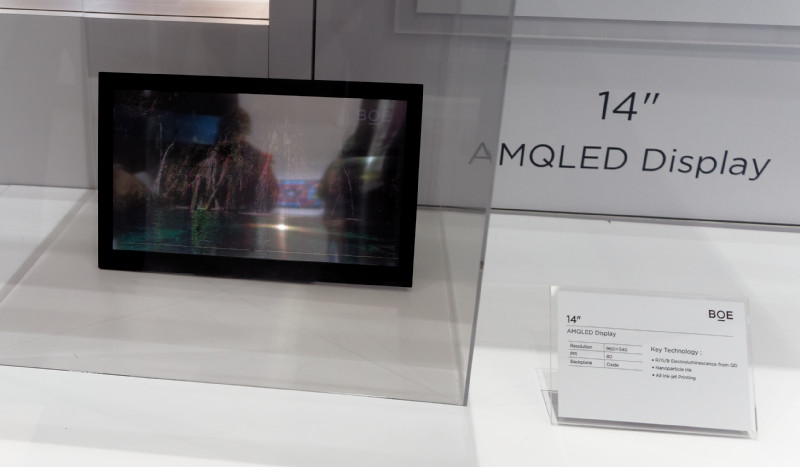 BOE showed this electro-emissive QD display that was said to have been made by inkjet printing. Image:Meko
BOE showed this electro-emissive QD display that was said to have been made by inkjet printing. Image:Meko
Turning to large panels for TV, there was a new 55″ UltraHD panel that uses wireless HDMI to create a ‘flat back’ module for dual box TV. The panel is just 5.2mm thick and uses a glass LGP to help achieve the slim form factor.
Analyst Comment
There was also a big 10K display for TV, but that was also shown last year, so wasn’t, technically, news. The range of panels shown by BOE, especially in the VR/AR/NTE area was very impressive. The company clearly sees head mounted displays as an important market for the future. I was also impressed by the appearance of an electro-emissive QD display. It was clearly a prototype, but I was surprised to see it at this stage. BOE is not just about cheap money and the Chinese TV market. It is genuinely pushing TV technologies forward. (BR)

